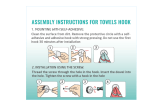
INSTALLATION INSTRUCTIONS
for Wood Patio Doors with Exterior Trim or Nailing Fin (JII026)
2
ROUGH OPENINGS
SAFETY AND HANDLING
MATERIALS AND TOOLS
FULLY SHEATHED WALL CONSTRUCTION
The wall framing is covered
by sheathing and the door
will be mounted with the
nailing n/exterior trim ush
against the sheathing. This
installation assumes building
wrap is properly installed
prior to installation.
OPEN-STUD CONSTRUCTION
If self-adhered ashing is to be applied so that it is wider than the
framing of the wall, it may be necessary to cover the wall with backing
support sufcient to support the entire width of the ashing.
This backing support should be a non water-degradable, thin (max. 1/8"
thick) sheet material such as vinyl sheeting. Completely surround the
rough opening with the backing support as shown. Backing support
must be applied before building wrap.
This installation guide specically addresses masonry/block wall,
sheathed wall and open-stud construction.
MASONRY/BLOCK WALL CONSTRUCTION
This installation
assumes that a building
professional has already
properly fastened and
sealed a framework of
studs (often called a
buck) to the concrete/
masonry wall.
PROVIDED MATERIALS
• Builders doors with a berglass sill will include a square drive bit,
9 - #8 x 1.5" screws for wood suboors, 4 - #10 x 3" strike plate and
2 - #8 x 2" head bracket replacement screws.
NEEDED MATERIALS
Note! JELD-WEN exterior window and door products should be
installed in accordance with JELD-WEN’s recommended installation
and flashing directions, which are shipped with the products or can
be found on our website: www.jeld-wen.com. Note that alternative
installation methods and flashing systems may be utilized at the
installer’s or owner’s discretion and, in such situations the installation
should be done in accordance with the flashing manufacturer’s
instructions. Follow all material manufacturers’ instructions for
proper use and compatibility. When using flashing, spray adhesive/
primer, sealant and foam products, we recommend using the
same manufacturer and verifying compatibility. It is the End User’s
responsibility to determine if dissimilar materials are compatible to the
substrates in the application.
SAFETY
• Read and fully understand ALL manufacturers’ instructions before
beginning. Failure to follow proper installation instructions may result in
the denial of warranty claims for operational or performance problems.
• Do not work alone. Two or more people are required. Use safe
liftingtechniques.
• Use caution when handling glass. Broken or cracked glass can cause
serious injury.
• Wear protective gear (e.g. safety glasses, gloves, ear protection, etc.).
• Operate hand/power tools safely and follow manufacturer’s
operatinginstructions.
• Use caution when working at elevated heights.
• If disturbing existing paint, take proper precautions if lead paint is
suspected (commonly used before 1979). Your regional EPA
(www.epa.gov/lead) or Consumer Product Safety Commission ofces
provide information regarding regulations and lead protection.
• WARNING: Drilling, sawing, sanding or machining wood products
generates wood dust, a substance known to the State of California to
cause cancer. Use a respirator or other safeguards to avoid inhaling
wood dust.
MATERIALS AND PATIO DOOR HANDLING
• Make sure the operating panel is secured prior to installation.
• Heed material manufacturers’ handling and application instructions.
• Protect adhesive surfaces from dirt, moisture, direct sunlight and
folding over onto themselves.
• Handle in vertical position; do not drag on oor.
• Do not put stress on joints, corners or frames.
• Store patio door in dry, well-ventilated area in vertical, leaning
position to allow air circulation; do not stack horizontally.
• Protect from exposure to direct sunlight during storage.
• Install only into vertical walls and when conditions and sheathing
aredry.
IF INJURY OCCURS, IMMEDIATELY SEEK MEDICAL ATTENTION!
Buck
Trimmer
studs
Header
Sheathing
Sill area
King
stud










